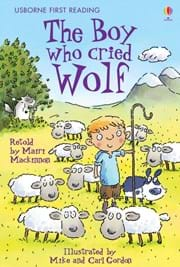Title of the work
Country of the First Edition
Country/countries of popularity
Original Language
First Edition Date
First Edition Details
Mairi Mackinnon, The Boy Who Cried Wolf. Usborne First Reading. London: Usborne Publishing Ltd., 2008, 48 pp.
ISBN
Genre
Fables
Instructional and educational works
Picture books
Target Audience
Children (c. 3–6)
Cover

Courtesy of Usborne Publishing Ltd.
Author of the Entry:
Sonya Nevin, University of Roehampton, sonya.nevin@roehampton.ac.uk
Peer-reviewer of the Entry:
Susan Deacy, University of Roehampton, s.deacy@roehampton.ac.uk
Dorota Mackenzie, Warsaw University, dorota.mackenzie@gmail.com

Carl Gordon (Illustrator)

Mike Gordon (Illustrator)
Mike Gordon is an acclaimed children's illustrator who typically works in a humorous style. Gordon is British and based in California, USA.
Source:
Official website (accessed: July 2, 2018).
Bio prepared by Sonya Nevin, University of Roehampton, sonya.nevin@roehampton.ac.uk

Mairi Mackinnon (Author)
Mairi Mackinnon is a British children's author with an extensive range of publications. Many of her books are designed to assist with reading and language development, including many phonics-orientated publications and titles for several languages in the Hundred First Words and First Thousand Words series. Mackinnon has written many of the Usborne First Readers titles. Her Aesop titles in that category include Sun and Wind, and The Lion and the Mouse, while non-Greek titles include retellings of other myths, such as The Leopard and the Sky God.
Bio prepared by Sonya Nevin, University of Roehampton, sonya.nevin@roehampton.ac.uk
Summary
This retelling of The Boy Who Cried Wolf, a traditional Aesop's Fable, is written in deliberately simple language for those learning to read. The series contains many examples of myths from around the world and simplified versions of classic literature, including those which suggest moral lessons for children to consider.
The "boy"' protagonist is called "Sam". He survives the final wolf attack. The story is told through a combination of main narrative and direct speech in bubbles.
Analysis
The illustrations place the story in the medieval period, as indicated by the villagers' clothing and the village's architecture. The architecture and mountainous landscape appear to place the story in Northern or Western Europe. This is perhaps intended to provide a balance between a northern European environment that is familiar to readers in northern Europe while still conveying the story's setting "long ago."
The moral of the story is made clear through the exchange between Sam and the villagers at the very end of the story ("You always told lies before." "I've learned my lesson. Never again"). This provides a positive and constructive end to the story, which differs from the traditional version in which the boy is killed in the wolf's last attack. The more violent version was perhaps deemed unnecessarily brutal for a very young audience. The story is followed by a four pages section, "About this story", which explains that this is "one of Aesop's (say Ee-sop's) Fables" from ancient Greece and known all over the world. The inclusion of this section – a version of which appears in many of the series' volumes – indicates that the origin of the story is regarded as part of the story's value and something which reinforces the message it carries. The moral of the story is revisited: an explicit summary moral in its own box relates that No one believes liars even when they tell the truth.
Further Reading
Cooper, Kenneth, "Aesop's Fables for Adults", Peabody Journal of Education 33.3 (1955): 143–147.
Finch, Chauncey E., "The Greek Source of Lorenzo Valla's Translation of Aesop's "Fables"", Classical Philology 55.2 (1960): 118–120.
Hall, Edith, "Our Fabled Childhood: Reflections on the Unsuitability of Aesop to Children", in Katarzyna Marciniak, ed., Our Mythical Childhood... The Classics and Literature for Children and Young Adults, Leiden: Brill, 2016.
Hall, Edith, "Aesop the Morphing Fabulist", in Owen Hodkinson and Helen Lovatt, eds., Classical Reception and Children's Literature: Greece, Rome and Childhood Transformation, London: I.B. Tauris, 89–107.
Kubiak Ho-Chi, Beata, "Aesop’s Fables in Japanese Literature for Children: Classical Antiquity and Japan", in Katarzyna Marciniak, ed., Our Mythical Childhood... The Classics and Literature for Children and Young Adults. Leiden: Brill, 2016.
van Dijk, J. G. M, "The Function of Fables in Graeco-Roman Romance", Mnemosyne 49.5 (1996): 513–541.
Weinlich, Barbara, "The Metanarrative of Picture Books: ‘Reading’ Greek Myth for (and to) Children", in Lisa Maurice, ed., The Reception of Ancient Greece and Rome in Children’s Literature. Heroes and Eagles, Leiden: Brill, 2015.


